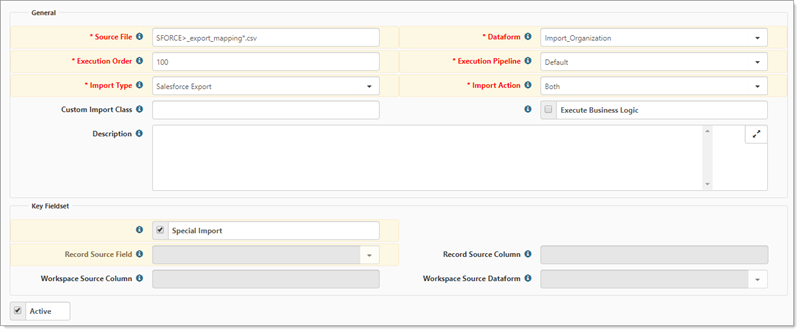Configuring Import/Export Mapping
The mapping of data between ClientSpace and Salesforce is defined using Import Map Headers.
Two Import Maps must be created:
| • | Export Map Header |
| • | Import Map Detail |
Export Map Header

| Field | Description |
|---|---|
| Source File | SFORCE_export_mapping*.csv |
| Dataform | Import_Organization |
| Custom Import Class | not yet implemented |
| Import Type | Salesforce Export |
| Execution Pipeline | ignored |
| Import Action | ignored |
| Execute Business Logic | ignored |
| Special Import | checked |
Import Map Header
Use Import Map Headers to map data between ClientSpace and Salesforce.
To create the Import Map Header:
| 1. | Go to System Admin The Import Map Header Search page is displayed. |
| 2. | Click Add. The Import Map Header Detail form is displayed. |

| 3. | Complete the form fields: |
| Field | Description |
|---|---|
| Source File | SFORCE_import_mapping*.csv |
| Dataform | Import_Organization |
| Custom Import Class | not yet implemented |
| Import Type | Salesforce Import |
| Execution Pipeline | ignored |
| Import Action | ignored |
| Execute Business Logic | ignored |
| Special Import | selected |
| 4. | Click Save. |
The next step is to add fields by configuring the import map detail.
To configure the Import Map Detail:
| 1. | Open the newly created Import Map Header. |
The Import Map Header Detail form is displayed.
| 2. | In Action Items, click Fields. |
The Import Map Search list is displayed, showing the existing fields.
| 3. | To add a field, click Add. |
The Import Map Detail form is displayed.
| 4. | Complete the form: |
| Field | Description | ||||||||||||||||||||||||||||||||||||
|---|---|---|---|---|---|---|---|---|---|---|---|---|---|---|---|---|---|---|---|---|---|---|---|---|---|---|---|---|---|---|---|---|---|---|---|---|---|
| Source Field | Ignored. Enter text that describes the source of this detail (OrgName or sfAcctName) for clarification. | ||||||||||||||||||||||||||||||||||||
| Field and Project Type |
This is where the data from Salesforce will be stored. Select any non-parent field type on any single-form.
|
||||||||||||||||||||||||||||||||||||
| API Path |
This is where the data from Salesforce will be retrieved. The format of this field is SF_ObjectType/FieldName (e.g., Account/BillingStreet).
For details on locating the API Path, see Finding the API Path in Salesforce. |
||||||||||||||||||||||||||||||||||||
| Data Type |
|
| 5. | Click Save. |
To configure the Import Map Detail for fields from multiforms:
Note: Before you complete this procedure, you must contact Professional Services about setting up the Salesforce API to use the csworkspacedataproc additional parameter with a custom stored procedure. You will use the variables from the custom stored procedure to define the fields to populate in Salesforce.
-
Go to System Admin
 > Advanced > Configure Import.
> Advanced > Configure Import. The system displays the Import Map Header Search page.
-
Click
 (Jump) for the row that contains the Salesforce mapping source file.
(Jump) for the row that contains the Salesforce mapping source file. The system displays the Import Map Header Detail page.
-
In Action Items, click Fields.
The system displays the Import Map Search, showing the existing fields.
-
Click Add to create a new field map.
-
Complete the following information in the form:
Field Description File Column Enter the variable from the stored procedure for the field that you are mapping to Salesforce. Dataform This is field must be blank so that the system can pull data by using the variable in the saved procedure that is associated with the Salesforce API csworkspacedataproc additional parameter.
Data Type Select a Data Type:
• Text: Most fields should be mapped as Text (even if the source or destination fields are integers or dates/etc.) • Lookup: Not yet implemented (use Text). • Foreign Key • Currently, this is only implemented for Imports and locating CS Users. • It accepts a Salesforce User ID and locates that User in ClientSpace by Email. A call is made to Salesforce using the SF User ID. The SF User Email is located and used to find a matching Email in ClientSpace. • Default Value • A Default Value can be set in this field. • If a Salesforce field does not exist, the API Path must be set to Object/UseDefault. This default value is set in the appropriate ClientSpace field. For Imports the Object is not important, the Default Value is set in the CS field. • Active, Required Value, and Required Column • Only Active records are used. • Required Value and Required Column settings are ignored. • Minimum Required Field API Path This is where the data from Salesforce will be retrieved. The format of this field is SF_ObjectType/FieldName (e.g., Account/BillingStreet).
• The only valid SF_ObjectType values are Opportunity, Account, Contact, Lead, Event, or Task. Other values are ignored. • Can only contain an SF_ObjectType and up to two subfields, as in Account/RecordType/Name. • Cannot contain special characters (other than ‘/’) and no spaces. • Salesforce fields that are Calculated are not exported by ClientSpace because Salesforce does not allow them to be directly updated. For details on locating the API Path, see Finding the API Path in Salesforce.
-
Click Save